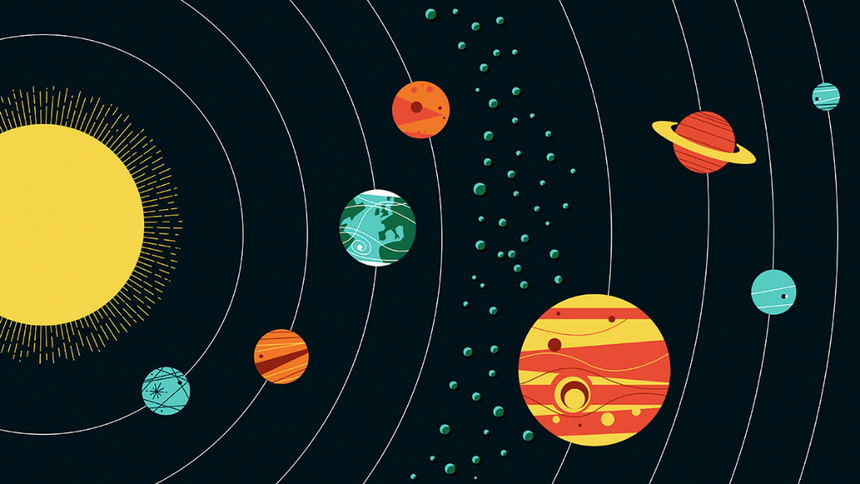Gravitational Force Escape Velocity - Detailed Guide
Gravitational force is one of the four fundamental forces of nature. The gravitational force plays an important role in keeping the Earth, the Sun, and every structure of the universe in motion. Escape velocity is the minimum speed essential to break free from the gravitational force of another massive body. In this article, we are going to have a full discussion on what is gravitational force, the definition of gravitational force, gravitational force examples, the discovery of gravitational force, the gravitational force of the earth, what is escape velocity, the escape velocity formula, derivation of escape velocity and factors affecting escape velocity.


What is Gravitational Force
Gravitational force definition: Gravitational force means the force of attraction between any two objects. The tendency of particles to move towards each other is called gravitation. The greater the mass of an object, the stronger the gravitational pull. Gravitational force depends on the :
- Masses of the objects
- The distance between them
Formula of Gravitational Force
The formula of gravitational force is given as:
where,
Gravitational Force Examples
What is gravitational force? Have you ever wondered why anything thrown up falls? Why doesn’t the moon fall to Earth? Why doesn’t the Earth fly off into the vast space rather than rotating in its orbit around the sun? Why do all the planets revolve around the sun? Why is going upstairs a lot more tiring than going downstairs? In all these cases there must be some force acting on the moon, the planets, and the falling bodies the force acting on them is called gravitational force one of the standing goals of physics is to understand the gravitational force. The force that holds us to the earth, holds all the objects surrounding you to earth, holds the moon in orbit revolving around the earth holds the earth and all planets in their path around the sun. This force is the reason for our Milky Way galaxy holding together billions of stars in the universe and the countless astronomical bodies between stars.
Gravitational Force Discovery
Gravitational force is a type of non-contact force. This is the force when the two interacting bodies are not in direct physical contact with each other, here, they can exert a push or pull despite their separation.
So, the question here is what causes the gravitational force?

There is a popular story that one day, Newton was sitting under an apple tree when an apple fell on his head and he suddenly thought of the force of gravitation. He thought about the following lines-
If the apple is accelerated there must be a force acting on it. If the force is at the top of the highest level the tree might not reach even further to the moon. By such reasonings, Newton concluded that,
Any two objects in the universe exert gravitational force of attraction on each other and he proposed the definition of gravitational force, as the force is directly proportional to the product of their masses and inversely proportional to the square of the distance between them.
Till now, we have understood the meaning of gravitational force very clearly and the importance of gravitational force on Earth as well as in the whole universe.
|
Related Topics, |
Calculate Acceleration Due to Gravity
According to Newton’s universal law of gravitational force,
Where,
As the force on a body is given as,
From equation (1):
Equating equations (1) and (2):
Dividing both sides by
By substituting all the values, we get the acceleration due to gravity as:
Calculate the Gravitational Pull Of Earth
As the moon revolves around the earth moon experiences a centripetal acceleration directed toward the earth an object near the earth's surface such as the apple experiences an acceleration g.
Newton calculated the acceleration of a body toward the earth is inversely proportional to the square distance of the body from the center of the earth by using the inverse square law.
According to the formula of inverse square law-
Where,
By substituting the values,
We get,
And,
Also,
Therefore,
Newton also calculated the centripetal acceleration of the moon from a knowledge of its mean distance from the Earth and its orbital.
As Centripetal Acceleration is
Where,
By substituting the value of
We get,
Similarly, the gravitational force of the Sun is also calculated.
The gravitational pull between the Earth and the Sun is equal to
The gravitational force on different planets is different because of their varying mass. More is the mass of the planet more is the gravitational force applied by it. Also closer anybody is more the gravitational force. Hence, in our solar system Jupiter has the maximum force on Earth and 2nd planet is Venus and Mercury has the lowest gravitational pull.
What is Escape Velocity
It is the minimum velocity required for an object to escape the gravitational pull of a massive celestial body. The escape velocity depends on the mass of the heavy body and the distance from its center to the object. The escape velocity of Earth is 11.2 km/s
Escape Velocity Formula
The formula of escape velocity can be expressed as:
where,
Derivation Of Escape Velocity
The gravitational potential energy of an object from the center of a celestial body is given as
The kinetic energy of the object is
To escape the escape velocity total energy of the object must be zero or greater
Thus,
Taking the square root we get
Factors Affecting Escape Velocity
- Mass of the celestial body
- Radius of the celestial body
- Gravitational Constant
- External gravitational influence
Also read:
Frequently Asked Questions (FAQs)
When a force acts on body, it produces acceleration whenever a body falls freely towards the earth under the effect of gravitational pull, its velocity changes with time. Therefore, the acceleration produced in the motion of body under the effect of gravity is called acceleration due to gravity.
Ball a ball thrown up in the air returns to the surface of the earth after traveling in the projectile motion because of the gravitational force.
Free falling of any object
If suppose your mass is 54kg then the force of gravity exerted by you on earth will be calculated as
F = 54 x 9.8 = 529.2 newton
The three basic laws of planetary motion given by kepler can be stated as,
- Kepler’s first law all planets move in an elliptical orbit with the sun at one of the foci of the ellipse.
- Kepler’s second law the line that joins any planet to the sun sweeps out equal areas in equal intervals of time.
- Kepler’s third law the square of the time period of revolution of a planet is proportional to the cube of the semi major axis of the ellipse placed out by the planet.
In physics, escape velocity is the minimum force that is required to escape the surface of the earth without any further acceleration the value of escape velocity is independent of the mass of the projectiles and it depends on the mass and radius of the planet from which it is being projected for example escape velocity is more on poles and less on equator.
Also Read
26 Nov'24 11:34 AM
18 Nov'24 01:04 PM
12 Nov'24 10:11 PM
12 Nov'24 10:08 PM
26 Sep'24 10:55 AM
26 Sep'24 10:54 AM
25 Sep'24 06:39 PM
25 Sep'24 06:26 PM
25 Sep'24 06:26 PM
25 Sep'24 06:25 PM

